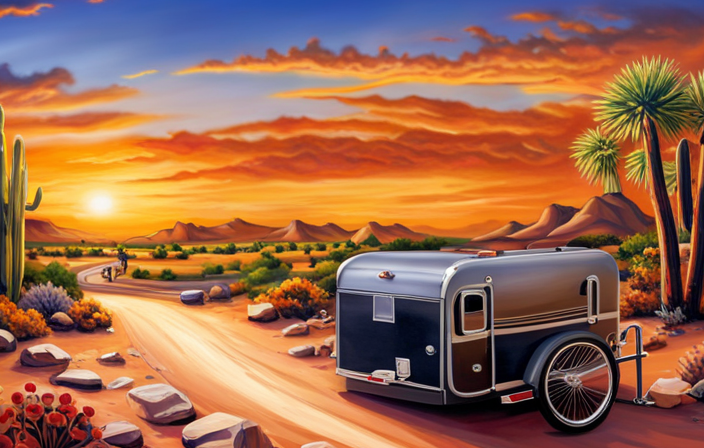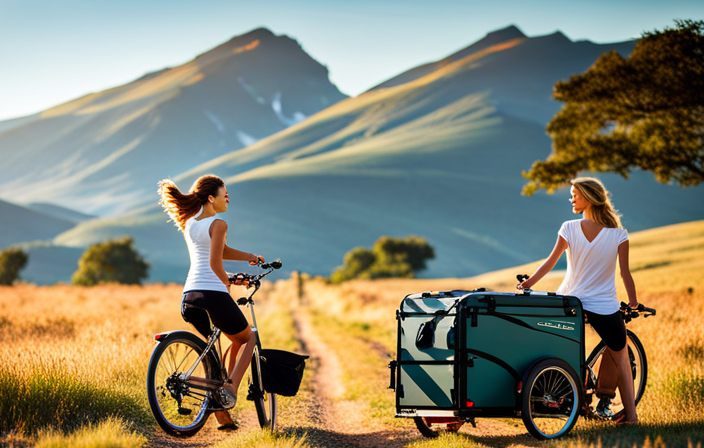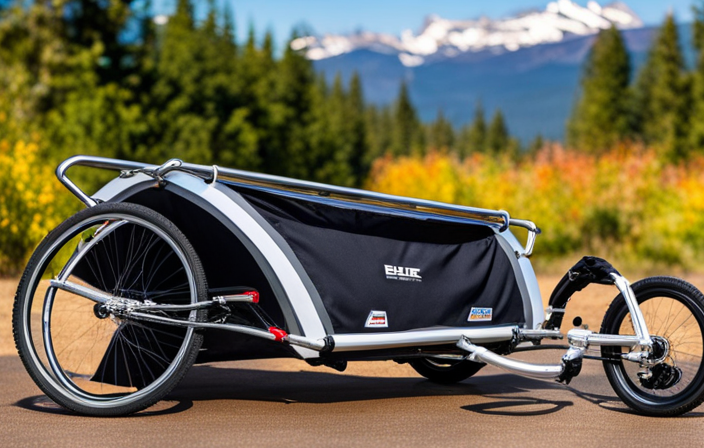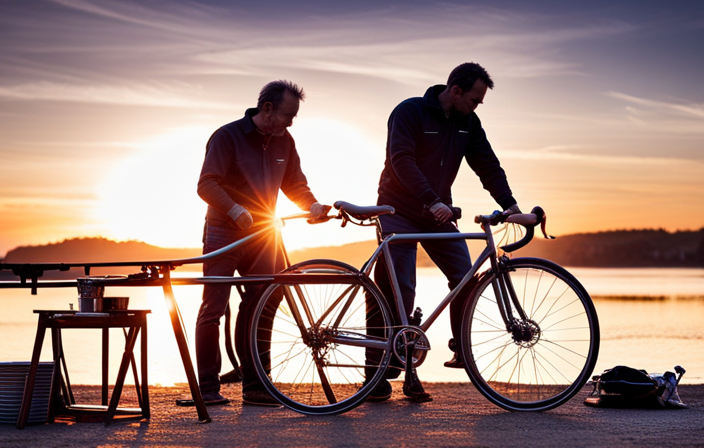I really enjoy biking with my young kids, and one of the most convenient methods is by using a bike trailer. These fantastic devices easily connect to your bike, enabling you to take your children with you on your biking excursions.
In this article, I will delve into the different types of bike trailers and the various hitch attachment mechanisms available. I’ll also share some popular bike trailer brands and models, as well as tips for a safe and enjoyable ride.
So, let’s get started and discover how bike trailers attach to bikes!
Key Takeaways
- Different types of hitch attachment mechanisms are available for bike trailers, including frame-mounted, seatpost-mounted, axle-mounted, quick release, and bolt-on options.
- Proper alignment and tightening of the hitch is crucial to ensure a secure attachment between the trailer and the bike’s frame.
- Distributing the weight of the trailer evenly and centering it helps maintain stability and control while riding.
- Bike trailers provide added stability and security, but the added weight and size may affect maneuverability, especially in narrow or crowded areas.
Different Types of Bike Trailers
You can choose from various types of bike trailers, each serving different purposes. Bike trailers come in all shapes and sizes, and they offer a range of features and accessories to enhance your cycling experience. Whether you’re looking to transport your kids, pets, or gear, there’s a bike trailer that’s perfect for you.
When it comes to bike trailer features, there are a few key factors to consider. First, you’ll want to think about the size and capacity of the trailer. Some trailers are designed to carry one child, while others can accommodate two or more. Look for trailers with adjustable seats and harnesses for added comfort and safety.
In terms of accessories, bike trailers offer a wide range of options. Many trailers come with storage compartments for carrying snacks, water bottles, and other essentials. Some trailers even have built-in suspension systems to provide a smooth ride over rough terrain.
As you explore the world of bike trailers, you’ll also come across different hitch attachment mechanisms. These mechanisms are what connect the trailer to your bike. They come in various styles, including coupler attachments, quick-release attachments, and universal attachments. Each type has its own benefits and considerations, so it’s important to choose one that fits your specific needs.
In the next section, we’ll dive deeper into the world of hitch attachment mechanisms and explore the pros and cons of each option.
Hitch Attachment Mechanisms
To attach the hitch mechanism of a bike trailer, simply align it with the rear axle and secure it using the quick-release lever. This straightforward process ensures a safe and reliable connection between your bike and the trailer.
When installing a bike trailer hitch, there are a few important factors to consider. Firstly, make sure to choose a hitch that is compatible with your specific bike model and trailer. This will ensure a proper fit and prevent any potential issues down the line. Additionally, it’s crucial to tighten the hitch securely to the axle to prevent any wobbling or detachment while riding.
If you experience any problems with the hitch attachment, such as difficulty aligning it or a loose connection, there are a few troubleshooting steps you can take. First, double-check that the hitch is correctly aligned with the rear axle and that the quick-release lever is tightened properly. If the issue persists, consider consulting the manufacturer’s instructions or seeking advice from a bike trailer expert.
With the hitch securely attached, you can confidently embark on your bike adventures, knowing that your trailer is firmly connected to your bike.
Now, let’s move on to the next section about the frame-mounted hitch.
Frame-Mounted Hitch
As a passionate cyclist, I love taking my furry friend on bike rides. I am excited to discuss the frame-mounted hitch for bike trailers.
This attachment mechanism works by securely connecting the trailer to the bike frame, ensuring stability and control while riding.
One of the pros of using a frame-mounted hitch is that it provides a solid connection between the bike and the trailer, allowing for better handling and maneuverability.
However, it’s important to note that the compatibility of frame-mounted hitches can vary depending on different bike frames, so it’s crucial to ensure compatibility before making a purchase.
How it Works
The bike trailer attaches to the bike using a secure and reliable mechanism. One common method is the frame-mounted hitch, which connects the trailer to the bike’s frame. To properly attach a bike trailer, start by aligning the hitch with the bike’s rear axle. Then, secure it tightly using the provided hardware. It’s important to ensure that the hitch is properly tightened to prevent any wobbling or detachment during the ride. Additionally, make sure the trailer’s weight is evenly distributed and centered.
Using a bike trailer has its pros and cons. On the positive side, it allows you to transport heavy loads or children with ease. It also offers stability and safety, keeping your cargo secure while riding. However, the added weight and size of the trailer can make the bike harder to maneuver and increase the braking distance.
With these considerations in mind, it’s important to evaluate whether a bike trailer is the right choice for your specific needs.
Pros and Cons
When considering a bike trailer, you should weigh the pros and cons to determine if it suits your specific needs.
One of the main advantages of using a bike trailer is its ability to evenly distribute the weight, ensuring a stable ride. This is especially beneficial when carrying heavy loads or transporting children.
Additionally, bike trailers offer excellent maneuverability and handling, allowing you to navigate tight spaces and corners with ease.
However, it’s important to consider the potential drawbacks as well. Bike trailers can add extra weight to your bike, which may affect your overall speed and agility. Furthermore, they can be more challenging to maneuver in narrow or crowded areas.
Despite these considerations, bike trailers remain a popular choice for cyclists looking to transport cargo or passengers.
Moving on to compatibility with different bike frames…
Compatibility with Different Bike Frames
After weighing the pros and cons of bike trailers, it’s time to consider their compatibility with different bike frames. This aspect is crucial because not all trailers are designed to fit every type of bike frame. Here are some important things to know:
-
Frame materials: Bike frames can be made of various materials such as steel, aluminum, carbon fiber, or titanium. It’s essential to ensure that the trailer attachment system is compatible with the specific frame material of your bike.
-
Trailer attachment compatibility: Some bike trailers are specifically designed for certain types of bikes, such as mountain bikes or road bikes. Additionally, it’s important to check if the trailer attachment is compatible with electric bikes, as they often have different frame designs and dimensions.
-
Compatibility adapters: In some cases, compatibility adapters can be used to bridge the gap between the trailer attachment system and your bike frame. These adapters can provide a secure and safe connection.
-
Consult the manufacturer: If you’re unsure about the compatibility of a bike trailer with your bike frame, it’s always best to consult the manufacturer or a knowledgeable bike shop for guidance.
Now that we’ve covered the compatibility aspect, let’s move on to the next section about the ‘seatpost-mounted hitch’ and its benefits.
Seatpost-Mounted Hitch
When it comes to bike trailers, the seatpost-mounted hitch is a popular choice for many riders. This type of hitch attaches directly to the seatpost of the bike, providing a secure and stable connection.
One of the key advantages of the seatpost-mounted hitch is its simplicity and ease of installation. However, it’s important to note that not all bike frames are compatible with this type of hitch, so it’s crucial to check the compatibility before making a purchase.
How it Works
The way bike trailers attach to bikes is by using a hitch that connects to the rear axle. There are different hitch options available, each with its own advantages and considerations.
When attaching a bike trailer, it’s important to consider weight distribution. The hitch should be positioned in a way that allows the bike and trailer to remain stable and balanced. This ensures a smooth and safe ride for both the cyclist and the passenger in the trailer.
The weight of the trailer should be evenly distributed between the bike’s rear wheel and the trailer’s wheels. This helps to maintain control and stability, especially when navigating turns or uneven terrain.
Considering these factors will help you choose the right hitch option and ensure proper weight distribution for a successful bike trailer experience.
Now, let’s explore the pros and cons of using a bike trailer.
Pros and Cons
To make an informed decision about using a bike trailer, you should consider the advantages and disadvantages.
Bike trailers have their pros and cons when it comes to safety considerations. One of the major benefits of using a bike trailer is that it provides a stable and secure way to transport your children or cargo. The attachment to the bike ensures that the trailer stays in place and doesn’t affect your balance while riding.
However, it’s important to note that bike trailers can make your bike wider and harder to maneuver, especially in tight spaces or crowded areas. Additionally, the added weight of the trailer can make it more challenging to ride up hills or on uneven terrain.
Overall, it’s crucial to carefully evaluate the safety aspects and trade-offs before using a bike trailer.
Speaking of bike trailers, another important aspect to consider is their compatibility with different bike frames.
Compatibility with Different Bike Frames
One thing to consider is how well bike trailers work with various types of bike frames. Different bike frame materials can affect the compatibility and functionality of bike trailers. Here are three key factors to consider:
-
Frame strength: Bike trailers typically have a weight capacity that should not be exceeded. It’s important to ensure that the bike frame is sturdy enough to support the weight of both the trailer and its cargo.
-
Frame design: The shape and geometry of bike frames can vary greatly. Some frames may have unique features or angles that may not be compatible with certain types of bike trailers. It’s important to choose a trailer that can be securely attached to the frame without compromising stability or maneuverability.
-
Material compatibility: Bike frames can be made from various materials such as aluminum, steel, or carbon fiber. Each material has its own strength and weight characteristics. It’s crucial to consider the weight capacity of the trailer and the material of the bike frame to ensure a safe and efficient towing experience.
Considering these factors will help you choose a bike trailer that is compatible with your bike frame and meets your weight capacity needs.
Now, let’s delve into the next section about the axle-mounted hitch.
Axle-Mounted Hitch
You can easily attach a bike trailer to your bike’s axle using an axle-mounted hitch. This type of hitch is compatible with most bike frames and provides a secure connection between your bike and the trailer. The installation process is straightforward and requires a few simple steps.
To attach a bike trailer using an axle-mounted hitch, you will need to follow these steps:
- Remove the nut and washer from your bike’s rear axle.
- Slide the hitch onto the axle, making sure it is aligned with the hole on the hitch arm.
- Replace the washer and nut, and tighten them securely.
- Attach the trailer’s hitch arm to the hitch, ensuring it is securely fastened.
By following these steps, you will have a reliable attachment between your bike and the trailer, allowing you to safely transport your cargo or little ones on your cycling adventures.
Now, let’s discuss the next section about quick release vs. bolt-on hitches. These two types of hitches offer different benefits and considerations, and understanding their differences will help you make an informed decision when choosing the right hitch for your bike trailer.
Quick Release vs. Bolt-On Hitches
Now that we’ve explored the axle-mounted hitch, let’s dive into the world of quick release and bolt-on hitches. These two types of hitches offer different advantages and disadvantages, catering to different needs and preferences.
Quick Release Hitches:
- Easy installation: Quick release hitches are designed to be easily attached and detached from the bike, making it convenient for those who frequently switch between riding with a trailer and without.
- Versatility: With a quick release hitch, you can use the same trailer with multiple bikes, as long as they are compatible with the quick release mechanism.
- Limited weight capacity: Quick release hitches are generally not as strong as bolt-on hitches, so they may have a lower weight capacity and may not be suitable for heavy loads.
Bolt-On Hitches:
- Secure attachment: Bolt-on hitches provide a more secure and stable connection between the bike and the trailer, ensuring that it stays in place even on rough terrains.
- Higher weight capacity: Bolt-on hitches are typically stronger and can handle heavier loads, making them ideal for hauling larger or heavier items.
- Permanent installation: Once installed, the bolt-on hitch becomes a permanent fixture on the bike, limiting the bike’s versatility for other uses.
When considering which type of hitch to choose, it’s essential to weigh your specific needs, such as convenience, versatility, and weight capacity.
Now, let’s move on to the next section, where we will explore important safety considerations when using bike trailers.
Safety Considerations
When it comes to bike trailers, safety is my top priority.
There are several key points to consider in order to ensure a safe and enjoyable ride.
First, weight limitations are crucial as exceeding the recommended weight can impact stability and maneuverability.
Second, stabilization features such as a low center of gravity and a wide wheelbase are essential for maintaining balance, especially when navigating uneven terrain.
Lastly, visibility and reflectors play a vital role in ensuring that other road users can see you and your trailer, enhancing overall safety on the road.
Weight Limitations
Make sure to check the weight limitations before attaching a bike trailer to your bike. It is crucial to understand the weight capacity of your trailer and ensure that you don’t exceed it. Distributing the weight properly is equally important to maintain stability and prevent accidents. Here are three key factors to consider:
-
Weight Capacity: Each bike trailer has a specific weight limit that it can safely carry. Exceeding this limit can strain the trailer’s frame and compromise its stability.
-
Distribution of Weight: It is essential to distribute the weight evenly inside the trailer. Placing heavier items closer to the trailer’s axle helps maintain balance and prevents the bike from tipping over.
-
Center of Gravity: The center of gravity should be low to the ground. This provides better stability during turns and prevents the trailer from swaying side to side.
By understanding and adhering to weight limitations and proper weight distribution, you can ensure a safe and stable ride.
Now, let’s move on to the next section, where we’ll discuss the importance of stabilization features.
Stabilization Features
To ensure a stable ride, you should consider the various stabilization features available on your bike trailer. Stabilization techniques play a crucial role in keeping your trailer balanced and secure.
One important aspect is weight distribution. By evenly distributing the load, you can prevent the trailer from swaying or tipping over. Look for trailers that have adjustable suspension systems or independent wheel suspension, as these features can greatly enhance stability.
Additionally, some trailers have built-in stabilizers that can be adjusted to fit different bikes. These stabilizers provide extra support and prevent the trailer from wobbling during the ride.
By investing in a trailer with effective stabilization features, you can enjoy a smooth and worry-free ride with your precious cargo.
Now, let’s move on to the next section about visibility and reflectors.
Visibility and Reflectors
One way to increase visibility on your ride is by attaching reflective tape to the sides and rear of your trailer. Reflectors are essential for night visibility, ensuring that you can be seen by other road users even in low light conditions. Here are three reasons why reflectors are crucial for your safety:
- Reflectors help to make your trailer more visible from different angles, alerting drivers to your presence on the road.
- Reflective tape enhances your trailer’s visibility even when there are no direct light sources nearby, increasing your safety during nighttime rides.
- Reflectors not only improve your own visibility but also allow drivers to judge the distance between their vehicle and your trailer, reducing the risk of accidents.
By properly attaching reflectors to your bike trailer, you can ride confidently knowing that you are doing everything possible to ensure your safety on the road.
Now, let’s move on to the next section and explore the process of installing and detaching bike trailers.
Installing and Detaching Bike Trailers
Attaching and detaching bike trailers is a simple process that can be done quickly and easily. As an avid cyclist and bike trailer enthusiast, I have gained extensive knowledge and experience in this area. To ensure a smooth and secure attachment, here are a few installation tips.
First, make sure the hitch on the trailer is properly aligned with the rear axle of your bike. This will help distribute the weight evenly and prevent any wobbling or swaying during your ride. Next, tighten the attachment mechanism securely to the bike frame, ensuring it is locked in place. It is also essential to check that the safety straps are fastened snugly around the bike seat post or frame. This provides an extra layer of security and prevents the trailer from detaching unexpectedly.
However, there may be times when you encounter common attachment issues. One common problem is difficulty in aligning the hitch properly. In such cases, try adjusting the height or angle of the hitch until it fits snugly onto the bike. Another issue could be a loose attachment mechanism. If this happens, check for any loose bolts or screws and tighten them accordingly. Additionally, ensure that the safety straps are not tangled or twisted, as this can hinder the attachment process. By troubleshooting these common issues, you can easily overcome any challenges that may arise during the installation of your bike trailer.
Now that we have covered the installation process and troubleshooting common attachment issues, let’s move on to the next section where we will discuss maintenance and care tips to keep your bike trailer in top condition.
Maintenance and Care Tips
When it comes to maintaining and caring for your bike, there are a few key points to keep in mind.
First, regular cleaning and lubrication is essential to keep your bike running smoothly and prevent any unwanted damage.
Secondly, it’s important to regularly check for any signs of damage or wear, such as loose bolts or worn-out brake pads, and address them promptly to avoid any potential accidents.
Lastly, proper storage and protection, like using a bike cover or storing it indoors, will help prolong the lifespan of your bike and keep it looking great.
Cleaning and Lubrication
To keep your bike trailer in good condition, it’s important to regularly clean and lubricate the attachment mechanisms.
Cleaning tips for your bike trailer include using a mild detergent and water solution to remove dirt and grime. Be sure to rinse thoroughly and dry completely to prevent rusting.
Proper lubrication is essential for smooth operation, and you can use a silicone-based lubricant on the attachment points and moving parts. Remember to wipe off any excess lubricant to avoid attracting dirt.
To summarize, here are three important cleaning and lubrication tips for your bike trailer:
- Clean your bike trailer regularly with a mild detergent and water solution.
- Rinse thoroughly and dry completely to prevent rusting.
- Use a silicone-based lubricant on the attachment points and moving parts, wiping off any excess.
By following these cleaning and lubrication tips, you can ensure that your bike trailer remains in top shape.
Now let’s move on to checking for any damage or wear.
Checking for Damage or Wear
Make sure you inspect the attachment mechanisms on your bike trailer for any signs of damage or wear. This is crucial for the safety and stability of your trailer when it is attached to your bike.
Begin by examining the hitch, which connects the trailer to your bike. Look for any cracks, dents, or loose parts that could compromise its functionality.
Next, check the coupler, which secures the trailer to the hitch. Ensure that it is securely fastened and free from any signs of wear and tear.
Lastly, pay attention to the weight distribution on the trailer. Uneven distribution can affect the stability of your ride. If you notice any issues, it is essential to address them before using the trailer.
By properly inspecting the attachment mechanisms, you can ensure a safe and enjoyable biking experience.
Moving on to storage and protection, it’s important to keep your bike trailer in a secure and protected location when not in use.
Storage and Protection
You should find a secure and protected location for storing and protecting your bike trailer. Storing bike trailers properly is essential to ensure their longevity and functionality. It is important to protect them from harsh weather conditions, theft, and damage. I recommend finding a dry and covered area, such as a garage or shed, to store your bike trailer when not in use. Additionally, using a bike trailer cover can provide an extra layer of protection from dust, dirt, and UV rays. To help you understand the importance of storing and protecting your bike trailer, here is a table highlighting the potential risks and the measures you can take to mitigate them:
| Risks | Protective Measures |
|---|---|
| Harsh weather conditions | Store trailer in a covered area |
| Theft | Lock trailer to a secure object |
| Damage | Use a trailer cover and inspect regularly |
Accessories and Add-Ons
When it comes to bike trailers, there are a few key accessories and add-ons that can greatly enhance your riding experience.
First and foremost, rain covers and weather protection are essential for keeping your child or cargo dry and comfortable during inclement weather.
Secondly, storage pockets and compartments provide convenient storage space for snacks, water bottles, and other essentials, allowing you to stay organized on your rides.
Lastly, safety flags and lights are crucial for ensuring visibility and alerting other road users to your presence, making your rides safer and more secure.
These accessories not only add functionality to your bike trailer, but also provide peace of mind knowing that you are well-prepared for any situation.
Rain Covers and Weather Protection
There’s a rain cover available for bike trailers that helps protect your belongings from getting wet. It’s a must-have accessory for any bike trailer owner who wants to ensure their cargo stays dry, no matter the weather. The rain cover is designed to fit securely over the trailer, keeping rain, snow, and even dust away from your belongings. With adjustable straps and a tight seal, it provides a reliable barrier against the elements. And the best part? It’s easy to install and remove, making it convenient for those unexpected rain showers. So whether you’re hauling groceries, camping gear, or your child’s toys, you can have peace of mind knowing that your cargo will stay dry and protected.
| Weather Protection | ||
|---|---|---|
| Keeps belongings dry | Adjustable straps | Easy to install |
Now let’s talk about another important feature of bike trailers: storage pockets and compartments.
Storage Pockets and Compartments
The storage pockets and compartments on bike trailers are perfect for keeping your belongings organized and easily accessible. Here are four reasons why I love these storage features:
-
Ample Space: The pockets and compartments are spacious enough to hold all my essentials, from water bottles and snacks to extra clothing and tools.
-
Organization: With designated pockets, I can easily separate my items, making it convenient to find what I need while on the go.
-
Easy Installation: The installation process for these storage pockets and compartments is straightforward. They securely attach to the trailer frame, ensuring stability and preventing any shifting during rides.
-
Additional Features: Some bike trailers even come with extra features like removable storage bags or mesh panels, providing even more options for organizing and accessing my belongings.
Now, let’s talk about another crucial aspect of bike trailer safety: the use of safety flags and lights.
Safety Flags and Lights
To ensure your visibility and safety while riding, it’s important to use safety flags and lights on your bike trailer.
Safety flags are bright, colorful flags that attach to the back of the trailer, making it more noticeable to other road users. These flags are particularly useful in areas with heavy traffic or low visibility conditions.
Bike trailer lights, on the other hand, are essential for riding at night or in poorly lit areas. They come in different forms, such as LED lights that can be attached to the back of the trailer or reflective strips that can be placed on the sides.
By using both safety flags and lights, you can greatly enhance your visibility on the road and reduce the risk of accidents.
Now, let’s move on to choosing the right bike trailer for your needs.
Choosing the Right Bike Trailer for Your Needs
When choosing the right bike trailer for your needs, you’ll want to consider factors such as size, weight capacity, and attachment method. Finding the perfect trailer can make all the difference in your biking experience with little ones.
Here are some key points to consider:
-
Size: Make sure the trailer is spacious enough to accommodate your child comfortably, with enough room for them to grow.
-
Weight Capacity: Check the trailer’s weight capacity to ensure it can safely carry your child and any additional gear you may need to bring along.
-
Attachment Method: Look for a trailer that attaches securely to your bike, providing stability and safety during your rides.
-
Suspension Options: Consider whether you want a trailer with suspension, which can help absorb bumps and provide a smoother ride for your child.
-
Safety Features: Look for trailers with safety features such as reflective materials, a five-point harness, and a sturdy frame.
Considering these factors will help you find a bike trailer that meets your specific needs and ensures a comfortable and secure ride for your little one.
Now let’s dive into popular bike trailer brands and models, so you can make an informed decision on which one is right for you.
Popular Bike Trailer Brands and Models
When it comes to bike trailers, there are a few key categories that stand out: top rated child bike trailers, highly recommended cargo bike trailers, and trusted pet bike trailer brands.
As a cycling enthusiast, I have done extensive research on these categories and I am excited to share my knowledge and passion with you.
Whether you’re a parent looking for a safe and comfortable ride for your child, a cyclist in need of extra storage space, or a pet owner wanting to bring your furry friend along on your bike adventures, there are excellent options available to suit your needs.
Top Rated Child Bike Trailers
One of the top-rated child bike trailers is easy to attach to your bike. It’s important to find a bike trailer that suits your needs and preferences. Here are some key features to consider:
-
Different price ranges: There are child bike trailers available at various price points, allowing you to find one that fits your budget.
-
Folding and storage options: Look for a trailer that offers easy folding and compact storage, especially if you have limited space at home or need to transport it in your car.
When it comes to child bike trailers, it’s essential to choose a reliable and secure option. Safety should always be a priority, so make sure the trailer has a sturdy frame, secure attachment mechanisms, and adequate safety features for your child.
Now, let’s move on to highly recommended cargo bike trailers, which offer additional versatility and functionality for your biking adventures.
Highly Recommended Cargo Bike Trailers
A highly recommended cargo bike trailer is perfect for adding versatility and functionality to your biking adventures. These trailers come in different sizes and have varying weight capacities, allowing you to transport a wide range of items with ease.
Whether you need to carry groceries, camping gear, or even larger items like furniture, a cargo bike trailer can handle the job. With their sturdy construction and durable materials, they are designed to withstand the demands of heavy loads and rough terrain.
I have personally used a cargo bike trailer on numerous occasions, and it has never let me down. The ample storage space and reliable attachment system make it an essential accessory for any cyclist.
Now, let’s move on to discussing trusted pet bike trailer brands, where you can find similar versatility and functionality for your furry friends.
Trusted Pet Bike Trailer Brands
If you’re looking for trusted pet bike trailer brands, you’ll find plenty of options to choose from. These brands offer high-quality trailers with various features and accessories to ensure the safety and comfort of your furry friend.
Here are five top brands to consider:
-
Burley: Known for their durable construction and easy-to-use design, Burley pet bike trailers come with features like a weather-resistant canopy and a removable floor for easy cleaning.
-
Schwinn: Schwinn pet bike trailers are popular for their affordability and versatility. They often include features like a mesh screen for ventilation and a folding design for convenient storage.
-
Aosom: Aosom specializes in pet bike trailers that prioritize safety. Their trailers typically have a sturdy frame, a safety leash inside, and reflectors for increased visibility.
-
PetSafe: PetSafe pet bike trailers are known for their spacious interiors and comfortable padding. They also offer additional accessories, such as a pet stroller conversion kit.
-
Solvit: Solvit pet bike trailers are designed with durability in mind. They feature a strong steel frame, large wheels for stability, and a rear door for easy loading and unloading.
When choosing a pet bike trailer, consider features like size, weight capacity, ventilation, and storage options. Additionally, accessories like rain covers, storage pockets, and safety flags can enhance your biking experience with your furry companion.
Now let’s delve into some tips for safe and enjoyable bike trailer rides.
Tips for Safe and Enjoyable Bike Trailer Rides
To ensure a safe and enjoyable bike trailer ride, it’s important to follow these tips.
Bike trailer safety is paramount, especially when it comes to riding with young children or pets. First and foremost, always make sure that the bike trailer is securely attached to your bike. Double-check the hitch and ensure that it is properly fastened.
It’s also crucial to regularly inspect the trailer for any signs of wear and tear, such as loose straps or damaged frames. Maintaining proper tire pressure is another key aspect of bike trailer safety. Underinflated tires can affect the trailer’s stability and handling, so be sure to check the pressure before each ride.
In addition to safety, bike trailer rides offer a multitude of benefits. Riding with a bike trailer allows you to spend quality time with your loved ones while enjoying the great outdoors. It’s a fantastic way to explore new places, whether it’s a park, a trail, or simply cruising through your neighborhood.
Bike trailer rides also promote physical activity and a healthy lifestyle. By incorporating bike rides into your routine, you and your family can stay active and strengthen your bond at the same time.
As we consider the importance of bike trailer safety, it’s essential to also be aware of the legal and safety regulations that govern their use.
Legal and Safety Regulations
Transition: Now that we have covered some valuable tips for safe and enjoyable bike trailer rides, it is crucial to understand the legal and safety regulations surrounding the use of bike trailers.
Current Subtopic: Legal and Safety Regulations
When it comes to bike trailer attachments, there are specific safety regulations and legal requirements that must be adhered to. These regulations vary from country to country and even from state to state, so it is essential to familiarize yourself with the specific rules in your area.
In most jurisdictions, bike trailers are considered a separate category of vehicle and are subject to specific safety standards. These standards typically cover aspects such as weight capacity, reflective materials, and proper attachment methods. It is crucial to ensure that your bike trailer meets these requirements to guarantee the safety of both you and your passengers.
Additionally, some areas may have age restrictions for passengers in bike trailers, requiring children to reach a certain age or weight before they can ride in one. It is crucial to check the local laws and regulations to ensure compliance and keep everyone safe.
With these safety regulations and legal requirements in mind, let’s now delve into some frequently asked questions about bike trailer attachments.
Frequently Asked Questions about Bike Trailer Attachments
Have you ever wondered about the most commonly asked questions regarding attaching a trailer to your bicycle? Well, let me share with you some insightful information about bike trailer attachment installation and compatibility.
Here are three crucial things you need to know:
-
Proper installation is key: When attaching a bike trailer to your bicycle, it is vital to follow the manufacturer’s instructions carefully. This ensures that the trailer is securely attached and reduces the risk of accidents or damage.
-
Consider compatibility: Not all bike trailers are compatible with every type of bicycle. Before purchasing a trailer, make sure to check its compatibility with your bike’s frame and attachment points. This will save you from any frustration or disappointment later on.
-
Regular maintenance is essential: To ensure the continued safety and functionality of your bike trailer attachment, regular maintenance is crucial. Regularly inspect the attachment points, wheels, and brakes for any signs of wear or damage. Additionally, lubricate moving parts to keep them in good working condition.
By understanding the importance of proper installation, considering compatibility, and maintaining your bike trailer attachment, you can enjoy safe and worry-free rides with your precious cargo.
So go ahead, attach that trailer to your bike and embark on new adventures with confidence!
Frequently Asked Questions
Can I attach a bike trailer to a mountain bike?
Yes, you can definitely attach a bike trailer to a mountain bike! Mountain bikes are compatible with most bike trailers, making it easy to bring along your gear or even your little ones on your outdoor adventures.
The benefits of using a bike trailer with a mountain bike are numerous. It allows you to carry extra gear without weighing down your bike, provides stability on rough terrain, and adds versatility to your biking experience.
It’s a game-changer for mountain biking enthusiasts!
How much weight can a bike trailer hold?
Bike trailer weight capacity varies depending on the model and design. Factors that affect the weight limit include the trailer’s construction, frame material, and wheel size. Other considerations include the trailer’s suspension system and the type of hitch used to attach it to the bike.
It’s important to check the manufacturer’s guidelines for the specific weight limit of your trailer to ensure safe usage.
Are bike trailers compatible with all bike sizes?
As a bike enthusiast, I’m excited to share that bike trailers are compatible with most bike sizes. Whether you’re looking for a bike trailer for children or pets, there are options available to suit your needs.
Manufacturers understand the importance of versatility, ensuring that bike trailers can be easily attached to various bike frames. So, regardless of your bike size, you can enjoy the convenience and joy of riding with your loved ones safely and comfortably.
Can I use a bike trailer with an electric bike?
Sure, you can definitely use a bike trailer with an electric bike! However, there are a few limitations to consider.
Electric bikes are generally heavier and have more power, so it’s important to choose a trailer that can handle the extra weight and stress.
The benefits of using a bike trailer with an electric bike are numerous though. It allows you to easily carry additional cargo or even transport kids, making your electric bike even more versatile and practical.
What is the average cost of a bike trailer attachment?
Bike trailer attachments come in a variety of styles, each with its own pros and cons.
The average cost of these attachments can range from $50 to $200, depending on the brand and quality.
The durability of bike trailer attachments varies, with some lasting for years of heavy use while others may require more frequent replacement.
It’s important to consider factors such as weight capacity, ease of attachment, and overall stability when choosing the right attachment for your needs.
Conclusion
In conclusion, bike trailers are a fantastic way to transport goods or enjoy family bike rides. With various attachment mechanisms such as frame-mounted, seatpost-mounted, and axle-mounted hitches, there is a trailer option for every bike and rider.
Brands like Burley and Thule offer high-quality trailers that are known for their durability and safety features. Remember to always follow legal and safety regulations, such as wearing helmets and using proper lighting, to ensure a safe and enjoyable ride.
For example, Sarah, a busy mom of two, uses a bike trailer to commute to work while also dropping off her kids at school. She loves the convenience and eco-friendliness of this mode of transportation, and it allows her to spend quality time with her children while staying active.
So go ahead, give bike trailers a try and experience the joy of riding with ease and convenience.









